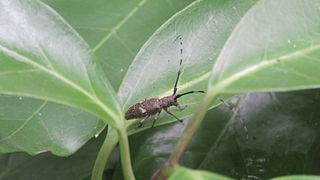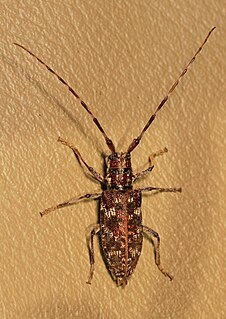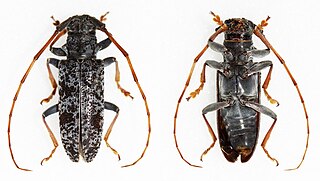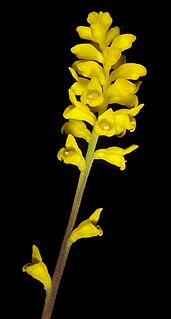
Teak is a tropical hardwood tree species in the family Lamiaceae. It is a large, deciduous tree that occurs in mixed hardwood forests. Tectona grandis has small, fragrant white flowers arranged in dense clusters (panicles) at the end of the branches. These flowers contain both types of reproductive organs. The large, papery leaves of teak trees are often hairy on the lower surface. Teak wood has a leather-like smell when it is freshly milled and is particularly valued for its durability and water resistance. The wood is used for boat building, exterior construction, veneer, furniture, carving, turnings, and other small wood projects.

Dino Grandi, 1st Conte di Mordano, was an Italian Fascist politician, minister of justice, minister of foreign affairs and president of parliament.

Banksia grandis, commonly known as bull banksia or giant banksia, is a species of common and distinctive tree in the south-west of Western Australia. The Noongar peoples know the tree as beera, biara, boongura, gwangia, pira or peera. It has a fire-resistant main stem with thick bark, pinnatisect leaves with triangular side-lobes, pale yellow flowers and elliptical follicles in a large cone.

Monochamus is a genus of longhorn beetles found throughout the world. They are commonly known as sawyer beetles or sawyers, as their larvae bore into dead or dying trees, especially conifers such as pines. They are the type genus of the Monochamini, a tribe in the huge long-horned beetle subfamily Lamiinae, but typically included in the Lamiini today.

The greater Chinese mole is a species of mammal in the family Talpidae. It is found in China and Vietnam.
Most railway stations in Italy are maintained and operated by RFI, a subsidiary of Ferrovie dello Stato Group. A minor part of them are operated by private and regional companies, conceded by the state.

Grandi Stazioni S.p.A. is a member company of Italy's Ferrovie dello Stato group. It was created to rehabilitate and manage, even commercially, the 13 biggest Italian railway stations.

Monochamus scutellatus, commonly known as the white-spotted sawyer or spruce sawyer or spruce bug, is a common wood-boring beetle found throughout North America. It is a species native to North America.
The fall of the Fascist regime in Italy, also known in Italy as 25 Luglio, came as a result of parallel plots led respectively by Count Dino Grandi and King Victor Emmanuel III during the spring and summer of 1943, culminating with a successful vote of no confidence against the Prime Minister Benito Mussolini at the meeting of the Grand Council of Fascism on 24–25 July 1943. As a result, a new government was established, putting an end to the 21 years of Fascist rule in the Kingdom of Italy, and Mussolini was placed under arrest.

Monochamus subfasciatus is a species of beetle in the family Cerambycidae. It was described by Henry Walter Bates in 1873. It is recorded from Japan where it infests Japanese red pine and is a vector of the nematode Bursaphelenchus doui.
Monochamus adamitus is a species of beetle in the family Cerambycidae. It was described by James Thomson in 1857. It is known from Tanzania, Sierra Leone, Angola, Ghana, Mozambique, the Ivory Coast, Senegal, the Democratic Republic of the Congo, Malawi, and Zimbabwe.

Monochamus sutor is a species of beetle in the family Cerambycidae. It was described by Carl Linnaeus in 1758, originally under the genus Cerambyx. It has a wide, natural distribution throughout Europe, and has also been introduced into Belgium and the Netherlands. Adults measure between 15 to 24 mm, and larvae measure up to 45 mm (1.8 in).

The spotted pine sawyer is a species of beetle in the family Cerambycidae. It was described by John Lawrence LeConte in 1852.

Monochamus galloprovincialis, the pine sawyer beetle, also referred to as the black pine sawyer beetle, is a species of beetle in the family Cerambycidae. It was described by Olivier in 1795, originally under the genus Cerambyx. It has a wide distribution, occurring naturally throughout Europe and the Caucasus. It has also been introduced into the Canary Islands. It serves as a vector for the parasitic nematode species Bursaphelenchus xylophilus, and also acts as a host to the parasitoid wasp species Dolichomitus tuberculatus.

Monochamus irrorator is a species of beetle in the family Cerambycidae. It was described by Chevrolat in 1855, originally apelled as "Monohammus" irrorator. It is known from the Republic of the Congo and Nigeria.
Monochamus leuconotus is a species of beetle in the family Cerambycidae. It was described by Francis Polkinghorne Pascoe in 1869, originally under the genus Anthores. It is known from Tanzania, Cameroon, Malawi, Kenya, Mozambique, Namibia, South Africa, Uganda, the Democratic Republic of the Congo, Zambia, Angola, and Zimbabwe. It feeds on Coffea arabica.
Monochamus ruspator is a species of beetle in the family Cerambycidae. It was described by Johan Christian Fabricius in 1781, originally under the genus Lamia. It has a wide distribution throughout Africa.

Monochamus sartor is a species of beetle in the family Cerambycidae. It was described by Johan Christian Fabricius in 1787, originally under the genus Lamia. It is known from throughout Europe, as well as in Kazakhstan, Mongolia, North Korea and South Korea. It is rated by the IUCN as Least Concern.
Monochamus thomsoni is a species of beetle in the family Cerambycidae. It was described by Chevrolat in 1855, originally under the genus Monohammus. It has a wide distribution throughout Africa. It contains the varietas Monochamus thomsoni var. buea.

Synaphea grandis is a shrub in the Proteaceae family, endemic to Western Australia.














